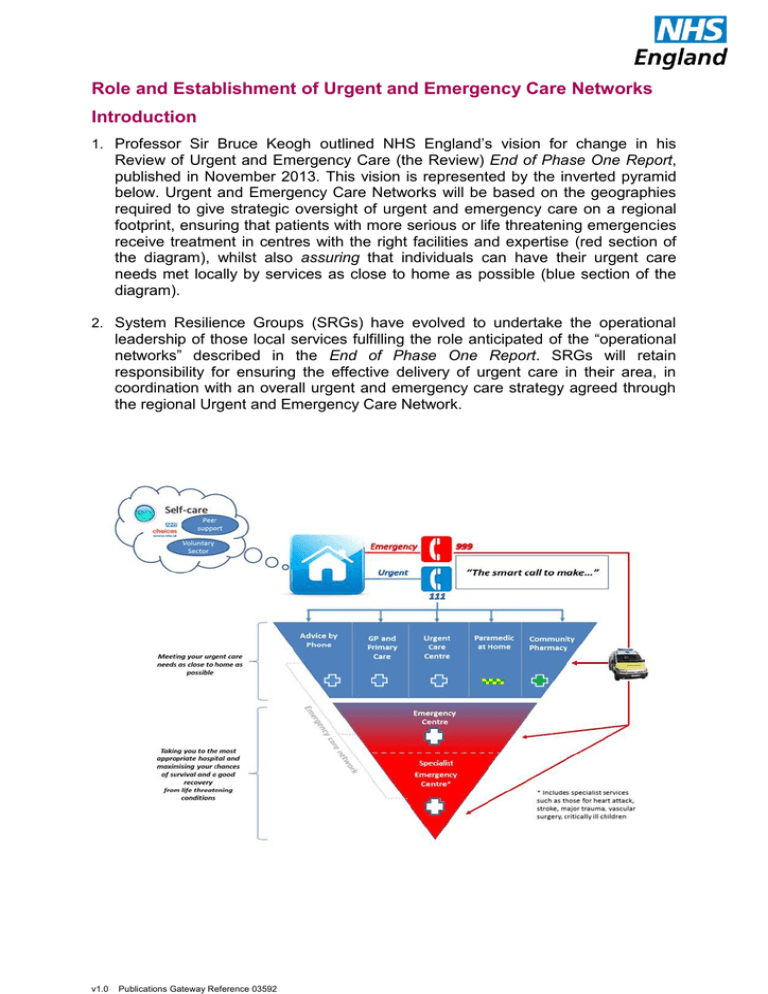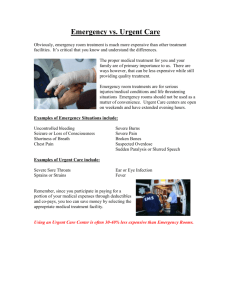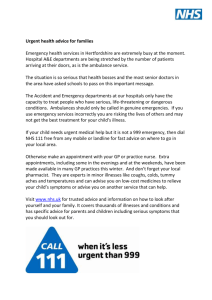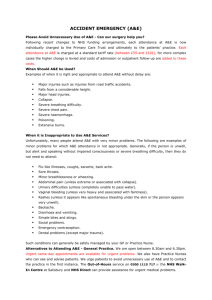Role and Establishment of Urgent and Emergency Care Networks Introduction
advertisement

Role and Establishment of Urgent and Emergency Care Networks Introduction 1. Professor Sir Bruce Keogh outlined NHS England’s vision for change in his Review of Urgent and Emergency Care (the Review) End of Phase One Report, published in November 2013. This vision is represented by the inverted pyramid below. Urgent and Emergency Care Networks will be based on the geographies required to give strategic oversight of urgent and emergency care on a regional footprint, ensuring that patients with more serious or life threatening emergencies receive treatment in centres with the right facilities and expertise (red section of the diagram), whilst also assuring that individuals can have their urgent care needs met locally by services as close to home as possible (blue section of the diagram). 2. System Resilience Groups (SRGs) have evolved to undertake the operational leadership of those local services fulfilling the role anticipated of the “operational networks” described in the End of Phase One Report. SRGs will retain responsibility for ensuring the effective delivery of urgent care in their area, in coordination with an overall urgent and emergency care strategy agreed through the regional Urgent and Emergency Care Network. v1.0 Publications Gateway Reference 03592 Purpose of Urgent Care Networks 3. The Urgent and Emergency Care Networks will operate strategically, covering a footprint of 1-5 million (depending on population density, rurality, and local factors). Their purpose is to improve the consistency and quality of UEC by bringing together SRGs and other stakeholders to address challenges in the urgent and emergency care system that are difficult for single SRGs to address in isolation. This will include coordinating, integrating and overseeing care and setting shared objectives for the Network where there is clear advantage in achieving commonality for delivery of efficient patient care (e.g. ambulance protocols, NHS 111 services, clinical decision support and access protocols to specialist services such as those for heart attack, stroke, major trauma, vascular surgery and critically ill children). 4. Objectives for Networks will include: a) Creating and agreeing an overarching, medium to long term plan to deliver the objectives of the Urgent and Emergency Care Review; b) Designating urgent care facilities within the network, setting and monitoring standards, and defining consistent pathways of care and equitable access to diagnostics and services for both physical and mental health; c) Making arrangements to ensure effective patient flow through the whole urgent care system (including access to specialist facilities and repatriation to local hospitals); d) Maintaining oversight and enabling benchmarking of outcomes across the whole urgent care system, including primary, community, social, mental health and hospital services, the interfaces between these services and at network boundaries; e) Achieving resilience and efficiency in the urgent care system through coordination, consistency and economies of scale (e.g. agreeing common pathways and services across SRG boundaries); f) Coordinating workforce and training needs: establishing adequate workforce provision and sharing of resources across the network; g) Ensuring the building of trust and collaboration throughout the network; spreading good and best practice and demonstrating positive impact and value, with a focus on relationships rather than structures. 5. Urgent and Emergency Care Networks will not undertake the service coordination functions and operational leadership, which can be done at a more local level, i.e. the operational functions of a SRG. SRGs will instead look to Networks to provide support on areas where they identify requirements beyond the SRG footprint, and where there is advantage in a uniformity in the provision of a standard of care. Reflecting the variation in size of networks, flexibility will be required on the exact split of responsibilities to ensure decisions are taken for an appropriate geography. 6. For SRGs, important operational objectives will include: a) Developing a plan to deliver against the 'high impact interventions' as agreed by the national tripartite; b) The translation and delivery of network service designations and standards to match the local provision of services. This will usually be achieved through the development of written plans and protocols for patient care, agreed with all 2 c) d) e) f) g) h) stakeholders, and adapted from national templates. High priority plans will relate to high-volume and undifferentiated conditions, where there are strong precedents for ambulatory and community-based patient management; Ensuring a high level of clinical assessment for the patient, in or close to their home, and ready access to diagnostics where required. This will be particularly important in more remote and rural communities, in which the role of smaller hospitals will be developed and strengthened; The development and utilisation of “clinical decision-support hubs” to support the timely and effective delivery of community-based care; Establishing effective communication, information technology and data sharing systems, including real-time access to an electronic patient record containing information relevant to the patient’s urgent care needs; The delivery of local mental health crisis care action plans to ensure early and effective intervention to prevent crisis and support people who experience mental health crisis; Ensuring the effective development and configuration of primary and community care to underpin the provision of urgent care outside hospital settings 24/7; and Achieving accurate data capture and performance monitoring. Establishment of Networks 7. Early actions that will need to be undertaken by Urgent and Emergency Care Networks include: a) Developing a clear membership structure and terms of reference; b) Agreeing the configuration of the Network and its structural components; c) An immediate initial stocktake of UEC services within the boundary of the Network, and an assessment of access and equity of provision by indices of deprivation and rurality; d) Fostering strong relationships and effective communication across the network, and building trust; e) Beginning to define the consistent pathways of care and equitable access to diagnostics and services across large geographies, for both physical and mental health, that will lead to longer term transformational service change. Network composition 8. We advise that all Networks should include within their boundary: Several System Resilience Groups; Several Clinical Commissioning Groups All acute receiving hospitals and Urgent Care Centres within the agreed Network boundary 9. The UEC Network should ensure appropriate representation from key organisations across the network geography, whilst maintaining a lean core membership. It is not expected that all organisations will sit on the network, but the following should be present or clearly represented: Constituent SRGs Constituent CCGs (including lead commissioner for ambulance services) All acute receiving hospitals and Urgent Care Centres At least one Health and Wellbeing Board At least one NHS 111 provider At least one GP out-of-hours provider 3 At least one ambulance service (most English ambulance services will be members of more than one network) At least one community healthcare provider At least one mental health trust and provider of health-based place of safety At least one local authority, to ensure an effective health scrutiny function NHS England regional representatives Community pharmacy services Health Education England through the Local Education and Training Board (LETB) Local Healthwatch, or similar patient and public representation Other key commissioned independent providers 10. There should be clear clinical input and coordination with the existing Strategic Clinical Networks (SCNs) and major trauma networks, Academic Health Sciences Networks (AHSNs), professional networks and engagement with a range of relevant third sector organisations. Networks will wish to consider engaging other services according to local circumstances, such as police. Networks should work in partnership to organise and oversee services, and should cover all but the most specialist (supra-regional) services, for which they will liaise with NHS England’s specialised commissioning services. 11. We advise that networks should be chaired by a senior commissioner; where this is not a clinician consideration should be given to appointing a clinical co-chair, and in all networks it is essential to secure clear and meaningful clinical and patient and public involvement. 12. Further advice on governance and support for networks will follow as part of the ‘route map’ for delivering the urgent and emergency care review. 4






